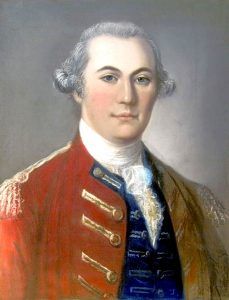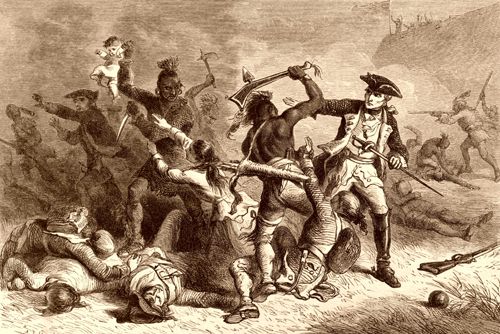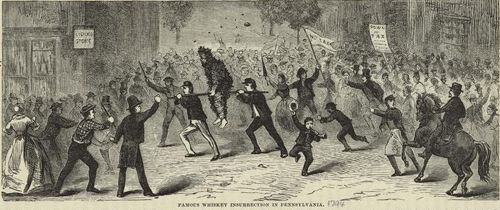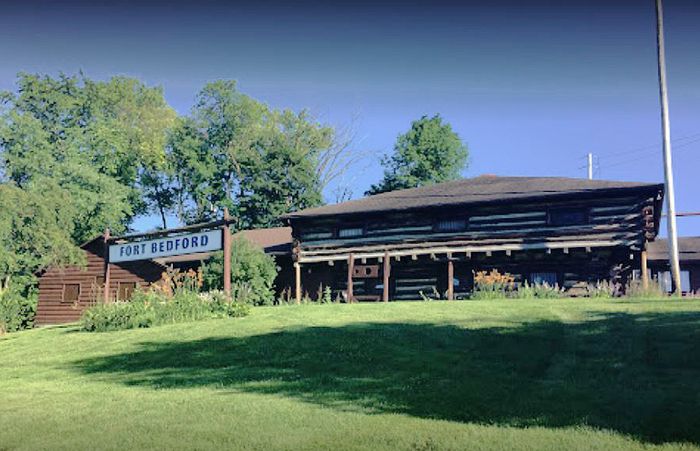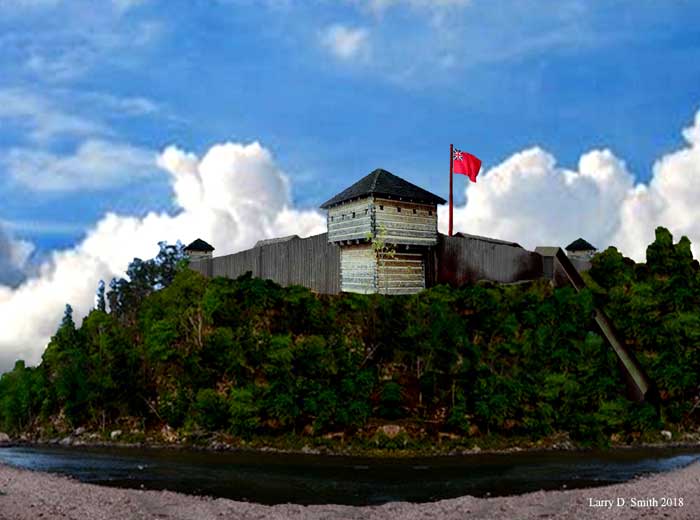
Artist rendition of Fort Bedford, PA, by Larry Smith, 2018.
A French and Indian War-era British military fortification, Fort Bedford was constructed about two miles west of Ray’s Trading Post (Raystown), Pennsylvania, established in 1751. The town of Bedford would be laid out around the fort in 1766.
After General Edward Braddock’s campaign to take the forks of the Ohio River ended in disaster, General John Forbes was placed in command of a new expedition to capture the strategic point guarded by Fort Duquesne. Forbes vowed not to make the same mistakes as his predecessor. Leading a small invasion force from western Maryland, his poorly defended supply and communication lines were soon compromised. Forbes quickly changed tactics, wanting to launch a significant invasion from eastern Pennsylvania; he ordered a new pioneer wagon road blazed over the Allegheny Mountains. His plan also called for a string of forts and blockhouses to guard the supply road from hostile Indian bands and the French. Called Forbes Road, the trail was blazed between June and November 1758.
In the meantime, General Forbes ordered Colonel Henry Bouquet and his men to begin constructing forts and blockhouses along the road. After constructing Fort Juniata Crossing near present Breezewood, Pennsylvania, Colonel Bouquet led the efforts in building a supply post for the troops on Forbes Road. After searching the area for some time, looking for a site that was both defensible and had access to fresh water, he could find no spot with both of these characteristics. He finally chose a site adjacent to the Juniata River west of a strategic mountain gap called “the narrows.” Keeping with the overall plan, the new site was about one day’s march from the Fort Juniata Crossing. The builders placed the fort on a high spot and devised an innovative fortified elevated gallery providing water access from the Juniata River. It is believed that Fort Bedford was the only fort ever constructed in America with this unique arrangement. The star-shaped log fortress was first called the “Camp at Raystown” but was soon renamed for the Duke of Bedford, a member of the Crown’s ministry during the French and Indian War.
Completed in the summer of 1758, the fort featured five bastions with walls that enclosed an area of approximately 1.45 acres and was surrounded by the river and a dry moat that was nine feet deep, ten feet wide at the bottom, and 15 feet wide at the top. The main gate was located on the structure’s south side and protected by an earthen rampart. The north side, which faced the river, featured the unique gallery to the riverbank.
Described as the “Grand Central Station of the Forbes campaign,” the fort became an important communication and supply link for Forbes’s army as it moved deeper into the wilderness. Along with Fort Ligonier and Fort Pitt, it completed the east-to-west axis of the British army’s fortification of western Pennsylvania. General Forbes and Colonel Bouquet also used it as their headquarters for portions of the campaign. The British thought it was impregnable.
After the bulk of the army moved westward, the fort was garrisoned by about 800 men but saw little action during the war.
As the French and Indian War neared its end, the troops were moved to other forts. Captain Lewis Ourry, in command of the fort at the outbreak of Pontiac’s Rebellion, listed just 12 Royal Americans on his roster to guard the fort, with an area population of about 90 local families. Despite the weakness of the garrison, the fort was never directly attacked by the Indians, who raided several local settlements and attacked supply trains bound for the fort. The arrival of reinforcements under Colonel Henry Bouquet in July 1763 ended most of the local raiding. After Pontiac’s Rebellion, the post fell into disuse, but by that time, numerous businesses and settlers had created the town of Bedford.
The fort was re-garrisoned by the Patriot-sympathizing Bedford County Militia during the American Revolution, guarding the area settlers against raids by British-allied native bands. It was said to have been the first British fort ever to be captured by American rebels when, in 1769, 18 men led by James Smith (aka the “Black Boys”) captured it by obtaining admission through a ruse. However, that appears to be false, as historical documents show that the British had abandoned the fort three years earlier. In addition, the only public record of the incident was written some 38 years after the event.
After the Revolutionary War had ended, several treaties in the 1780s, including the Treaty of Fort Stanwix and the Treaty of Fort McIntosh, reduced the fear of Indian raids in the area, and the fort was soon abandoned and later razed. George Washington stopped at the town of Bedford while leading troops into Western Pennsylvania to put down the Whiskey Rebellion in 1794 when the fort was gone.
In 1958, the log blockhouse was reconstructed in Bedford in honor of the fort’s 200th anniversary. It is currently a museum operated by Bedford County. The museum is located at 110 Fort Bedford Drive in Bedford, Pennsylvania. The exact location of the post has been lost to history, even though several archaeological digs have been conducted. However, using period documents, historians believe it was located somewhere along what is now East Pitt Street in Bedford, Pennsylvania. Author Larry Smith describes the area today; “Five buildings front Pitt Street at the present time, stretching the length of 300 plus feet between and including the Espy and Anderson Houses. The three buildings, which presently occupy the half-block between the Espy and Anderson Houses, are occupied by the businesses of Knisely & Sons Inc., Unique Stitches Quilt Shop, and the Golden Eagle Inn at 125, 127, and 131 E. Pitt Street, respectively. All Five buildings would have been built over what was a dry moat along the stockade wall of the fort.”
More Information:
Fort Bedford Museum
110 Fort Bedford Drive
Bedford, Pennsylvania 15522
814-623-8891
© Kathy Alexander/Legends of America, updated November 2022.
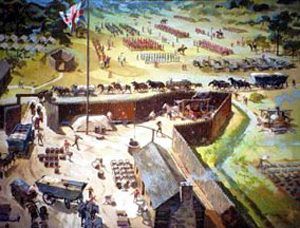
Fort Bedford, Pennsylvania
Also See:

